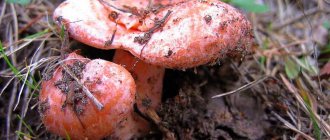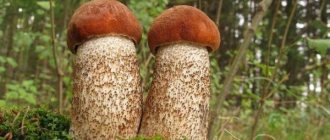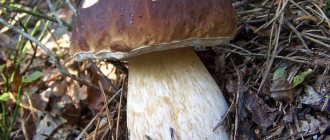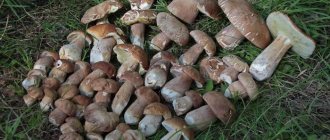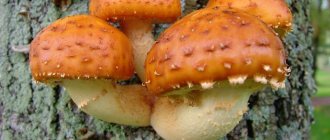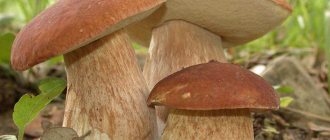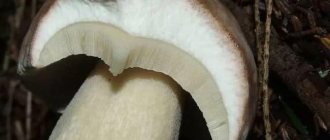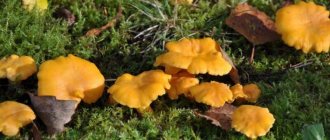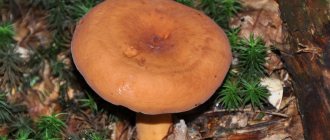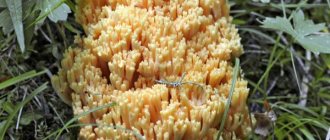3.3 / 5 ( 7 votes)
In Russia, the Polish mushroom grows in Siberia and the Far East, where it begins to grow in June and is found until late autumn. It is widespread in Europe, especially in Transcarpathia and Poland, where it is considered a valuable and nutritious product.
He has many doubles. How false mushrooms are similar to Polish mushrooms depends on their genus: it can be confused with safe fly mushrooms or inedible representatives of boletus mushrooms. It slightly resembles a boletus, but, unlike its brother, its flesh turns blue when broken and then acquires a brown tint.
Where does the Polish mushroom grow?
The Polish mushroom received its name due to its place of greatest distribution. In Poland, this type of mushroom is the leader in terms of collection volumes. In Russia it is often called the chestnut moss mushroom, Pansky or brown mushroom. It grows in the European part and the Far East. In Europe it is considered a delicacy due to its rich taste and content of nutrients. The Polish mushroom also paid attention to North America.
Polish mushrooms prefer mixed or coniferous forests with acidic soils in the northern temperate climate. The collection time for this species is from June to October. Under favorable weather conditions, peak yield occurs in September.
The fungus grows at the bases of old trees: spruce, oak, beech - either next to stumps, in groups or one at a time, forming mycorrhiza with them. Belongs to the Boletov family from the Borovikov family.
Twin mushrooms
Autumn is the season for collecting forest grain. Every year, at the end of summer, summer residents put things aside and go to the nearest forest in search of mushrooms. Fragrant and beautiful to look at, they can be deadly. The toxins of various inedible mushrooms have different effects on the human body. Often untimely and insufficient assistance leads to the death of the victim. As a result, he may die in no time. The highest mortality rate from mushrooms was recorded among the rural population, where transportation of patients and primary medical care are difficult.
Children are more susceptible to the effects of toxins. Therefore, in case of mushroom poisoning, the survival rate is higher in adults. In this case, human health largely depends on the speed of provision of first aid.
Description and useful properties
To choose the right one, the mushroom picker needs to know the exact description of the Polish mushroom:
- Cap: brown, with a diameter of 3 to 15 cm. The shape is convex, at the beginning of growth the edges are curled, then it takes on a flatter appearance. The surface is velvety; in dry weather it remains dry, but in damp weather it becomes slimy and slippery, and has the property of being difficult to separate.
- Cap color: ranges from bright red-brown to dark chestnut-brown.
- Hymenophore: tubular, at first (in young mushrooms) it has a light yellowish tint, which becomes greenish as it grows. This shade changes under mechanical influence, becoming bluish, blue-green or even brownish-brown.
- Pulp: white in color, dense consistency, turns slightly blue when cut, then turns brown and turns white again.
- Smell: light, fruity or mushroom.
- Taste: pleasant, sweetish.
- Leg: reaches 14 cm in height, up to 4 cm in diameter, cylindrical, slightly swollen at the bottom, may have a curved shape. The color is always lighter than the cap, in brown tones (yellow in the upper part). When you press on it, it first turns slightly blue, then turns brown.
Growing at home
Today, avid amateur mushroom pickers have begun to grow many types of mushrooms at home on their own, turning this from a favorite hobby into a fairly profitable business. Polish mushrooms can also be classified as such “household” mushrooms, which, with good and proper care, will delight their owners with a generous harvest more than once a year.
Land requirements
For growing Polish mushrooms, a small plot of land of about 2-3 square meters in a dark place or semi-dark room is best suited. First you need to dig a shallow ditch up to 30 cm and fill it with a nutrient mixture. At the very bottom you need to place a 10 cm layer of wood dust, fallen leaves, bark or grass, and then another 10 cm of manure humus or soil from under the trees. After preparing such a nutrient base, mushroom mycelium is evenly distributed over the entire surface of the pit. On top there is again 3 cm of plant residues, and finally - 3-5 cm of good soil from the garden.
Temperature and watering
Immediately after sowing and subsequently, as needed, the mushrooms must be constantly moistened, especially if the yard is hot and dry. The most favorable temperature for their good growth is 12-26 °C.
Since mushrooms do not have a growing season, they can be grown all year round, only to do this they must first be transplanted from open ground into boxes.
Ripening period
If everything is done correctly and in a timely manner, then 1.5-2 months after sowing the first mushrooms will appear, which in the future will delight their owners with new shoots every week and a half.
How to distinguish false Polish mushroom
False doubles of the Polish mushroom are easily confused by inexperienced mushroom pickers with the Polish porcini mushroom. The most common varieties of twins are moss mushrooms (variegated moss moss, m. brown, m. green). This category of mushrooms is not dangerous, but they are not used for cooking.
Their main external difference is a red-brown cap with cracks through which one can see the red-pink flesh (in the variegated flywheel) or light yellow (in the green flywheel) and a light yellowish leg. In the brown flywheel, dry whitish-yellow flesh is visible through cracks in the dark brown or dark brown cap.
Often inexperienced doubles are confused with birch porcini or spruce porcini mushroom, which in itself is very strange, because It is very difficult to find common features between these species in appearance. If we take the differences, we can highlight:
- The porcini mushroom has a barrel-shaped stem;
- the pulp does not turn blue when scrapped;
- on the surface of the leg there is a clearly visible convex mesh, etc.
We can also say that the Polish mushroom, again, can be confused with a gall mushroom by extremely inattentive mushroom pickers.
general information
The Polish mushroom is so called because previously it was imported to European countries mainly from “gentry” Poland, where the entire elite (called gentlemen) loved to eat it and considered it noble food. That is why this mushroom is also called pan mushroom.
The Polish mushroom is edible, belongs to the second category, is quite popular among mushroom pickers, and is also in great demand for its pleasant taste and many ways of preparation.
— Advertising —
The Polish mushroom (also known as the brown mushroom and the chestnut mushroom) belongs to the Boletaceae family, the genus Boletaceae, and is also included in the genus Boletus.
Features of collection
Don't pick mushrooms along the roads
Like any mushroom, the Polish mushroom is capable of accumulating hazardous substances from the environment in the fruiting body. Therefore, for safety reasons, you should refrain from collecting along roads and near industrial facilities.
To preserve the mycelium, it is recommended to cut the fruiting body carefully and make sure that it is edible. After this, carefully examine the mushrooms for the presence of worms (insect larvae): one infected one can ruin the entire contents of the basket in a few hours.
If the wormy areas are small, they can be carefully trimmed off. It is advisable to choose young specimens: they have better taste. Old and overripe can cause eating disorders.
After returning from the forest, the collected mushrooms are processed within 24 hours. If stored for a longer period of time, they overheat, cake and deteriorate.
Useful properties and contraindications
In terms of nutritional properties, the Polish mushroom is classified as a food product with a high content of vitamins and microelements. At the same time, the calorie content in it does not exceed 19 kcal per 100 g of pulp, which makes it dietary:
- proteins – 1.7 g;
- fats – 0.7 g;
- carbohydrates – 1.5 g.
Polish mushroom (fruiting body extract) contains antioxidants, thiamine and other essential amino acids that have a number of beneficial properties:
- calm the nervous system;
- help lower blood pressure;
- reduce the risk of developing atherosclerosis;
- improve the condition of nails and hair;
- help reduce weight.
The chemical composition of pan mushroom contains the following vitamins:
- Groups B (B1, B2, B9, B12);
- Ascorbic acid (C).
The following macro- and microelements were also found in its composition:
- potassium;
- phosphorus;
- iron;
- zinc;
- calcium;
- manganese;
- fluorine;
- sodium;
- magnesium;
- copper;
- selenium.
The Polish mushroom has an interesting property - the ability to cleanse the soil of heavy metals and accumulated radiation (absorbs it). It is also used in folk medicine. Pan mushroom is used in traditional Chinese medicine, where it is used to reduce weight, blood pressure and as a sedative.
Irina Selyutina (Biologist):
The famous Russian mycologist M. Vishnevsky writes about Polish mushrooms that:
- Studies have shown that the alcohol extract obtained from fresh fruiting bodies contains polysaccharides with antitumor activity against sarcoma-180 and Ehrlich carcinoma (experiments conducted on mice) by 60 and 70%, respectively.
- Methanol (CH3OH) extract based on dried fruiting bodies showed high antioxidant activity. But the same extract, but obtained using fresh fruiting bodies, showed excellent results in neutralizing active oxygen in comparison with all known types of mushrooms that have the same antioxidant properties.
- Polish researchers managed to find out that this type of edible mushroom is a hyperaccumulator of mercury, cobalt, cadmium and lead contained in the soil. After the accident at the Chernobyl nuclear power plant in 1986, their hyperaccumulation of radioactive cesium-137 was established.
- Currently, a method is being developed for using the Polish mushroom to cleanse the soil in those places that have been subjected to such a specific infection.
In addition to the benefits, mushroom dishes can also cause harm. For example, people who have problems with the digestive system. A large amount of mushrooms consumed as food can cause digestive upset. Interestingly, the Polish mushroom is one of the species that does not have poisonous counterparts.
Culinary processing and consumption
To prepare for cooking, the contents of the basket are poured onto a flat, dry surface and carefully inspected, getting rid of any that are spoiled or too old. After making sure that all specimens are edible, remove the damaged areas, cut off the lower part with the remains of mycelium, debris and dirt. By the way. The thin skin covering the cap does not need to be removed.
After thoroughly washing under running water, the mushrooms are soaked for 15-20 minutes, salt is added. Then they are washed again, the small ones are left whole, and the large ones are cut into pieces.
When cooking Polish mushrooms, the first broth is drained, then refilled with water and boiled with the addition of salt and spices. The mushrooms are then used for frying, stewing, freezing, drying or pickling.
Polish mushrooms are characterized by professional cooks not only as a species that has a delicate taste and pleasant aroma, but also practically does not boil down during the cooking process and does not lose its quality during heat treatment.
However, despite their good taste, you should not use them raw for salads - it is better for these purposes to first be fried or boiled.
Recipes and cooking features
After careful heat treatment, the Polish mushroom can be pickled, frozen, dried, or fried. In terms of its taste, this mushroom resembles white mushroom, which is why it is the most popular when preparing various dishes.
Processing rules
Washed and carefully peeled Polish mushrooms are cooked in small batches. One should take into account the fact that during the heat treatment foam is released that needs to be removed. Therefore, you should choose a larger capacity.
Processing Polish mushrooms
Large specimens are cut into several parts, and small ones are placed whole in a container. The mushrooms are placed in boiling water and after boiling, boiled for 10 to 20 minutes. This time is enough for the mushrooms to cook. The water is drained after processing. When the liquid is drained, the mushrooms quickly darken. Therefore, before cooking, the mushrooms are left for a short time in the cooking water.
Recipe for marinated Polish mushrooms
To prepare 2 kg of pickled mushrooms you will need:
- 1 liter of water,
- 1 teaspoon sugar;
- 2 tbsp. spoons of salt;
- 3 tbsp. spoons of vinegar (9%);
- 3 pcs. allspice;
- 1 PC. carnations;
- 3 pcs. black peppercorns;
- one bay leaf.
First, you need to cook a marinade from the indicated ingredients: add salt, sugar, all spices to boiling water, boil for 3-5 minutes and pour in vinegar. Place pre-cooked mushrooms in the marinade and boil. After this, the mushrooms are placed in clean, sterilized jars and sealed with lids.

